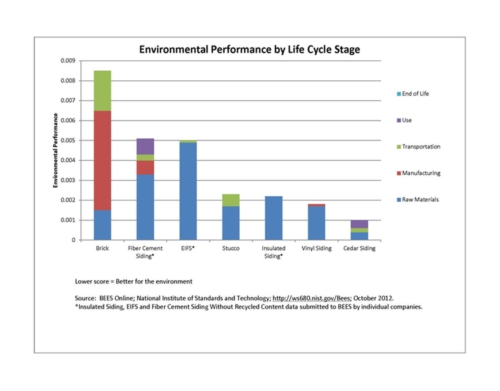Jan 23 2013
Vinyl siding ranks as one of the most environmentally-friendly exterior claddings today, as confirmed by a life cycle assessment (LCA) using Building for Environmental and Economic Sustainability (BEES®) software and published by NIST, the National Institute of Standards and Technology.
 Vinyl siding ranks as one of the most environmentally-friendly exterior claddings today, as confirmed by a life cycle assessment using Building for Environmental and Economic Sustainability software and published by NIST, the National Institute of Standards and Technology. (PRNewsFoto/Vinyl Siding Institute, Inc.)
Vinyl siding ranks as one of the most environmentally-friendly exterior claddings today, as confirmed by a life cycle assessment using Building for Environmental and Economic Sustainability software and published by NIST, the National Institute of Standards and Technology. (PRNewsFoto/Vinyl Siding Institute, Inc.)
This LCA, being released by the Vinyl Siding Institute, Inc., (VSI) is an important tool for builders, remodelers, architects, planners, and homeowners to use when comparing exterior cladding, including vinyl siding, insulated siding, fiber cement and brick.
Key findings from the green paper include:
- Vinyl siding outperforms fiber cement and brick, in all life cycle stages for environmental and economic performance when analyzed using the Building for Environmental and Economic Sustainability (BEES®) software.
- Fiber cement has nearly three times the environmental impact of vinyl siding and has more than double the environmental impact of insulated siding.
- Compared to vinyl siding, fiber cement contributes almost twice as much to global warming
- Vinyl siding's installed cost is typically lower than fiber cement. It never requires painting, staining or sealing, and can be cleaned with mild soap and water. This lowers the cost of maintenance and ensures that vinyl siding is not responsible for releasing harmful solvents into the environment.
- Brick has almost five times the environmental impact of vinyl siding and nearly four times the environmental impact of insulated siding.
- Brick contributes nearly seven times more to global warming/climate change than vinyl siding and more than five times more than insulated siding.
- Approximately five times more energy is required to manufacture brick and mortar than vinyl siding or insulated siding.
- Vinyl siding and insulated siding release fewer toxic chemicals into the environment than other exterior cladding through their life cycle.
The graph highlights the overall performance for a variety of exterior claddings. It's important to note that the lower the number, the better, or less impact, on the environment.